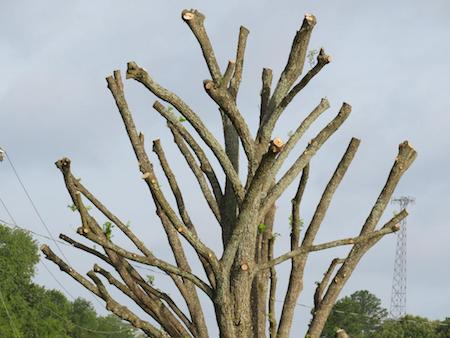
Topped trees are unsightly, unhealthy, and dangerous in the future.
December 31, 2023 - Winter is the time of year that glaring examples of tree topping shows up. Crapemyrtles are the most common victim, but this crude practice also occurs on large shade trees and other ornamental specimens. Topping however, is never a recommended practice for any shade or ornamental tree.
Topping is the indiscriminate and drastic cutting of tree branches. Topping disfigures trees and is detrimental to the tree’s health, structure, and value. Trees are alive, growing, breathing organisms. Topping causes many things to happen, none of which are good.
In the most severe cases, topping can lead to the death of a tree. Topping removes a tree’s potential food production (foliage) along with food stored in limbs that are cut. It also causes a tree to use valuable food stored in the trunk and roots to regrow limbs and branches. Topping redistributes the use of energy and has a substantial impact on a tree’s internal physiology.
Topping results in other problems for trees, the most severe being internal decay. When a branch is correctly pruned at its point of attachment to the trunk, just outside of the branch collar, internal decay is usually stopped from progressing into the trunk by a barrier inside the collar. A correct cut results in more rapid wound closure by callus tissue so that the bark's continuity is eventually re-established. Stubs produced by topping harbor decay fungi which eventually break down the barrier in the collar and then proceed into the trunk. Whenever a cut is made in the main leader by topping, there is nothing to prevent decay from developing in the trunk. The tree may be structurally weakened, and its life span reduced.
The drastic removal of limbs by topping also exposes the remaining limbs to the sun. This sudden exposure to intense light and heat can kill or damage a tree’s living tissue (the bark and cambium) and is called sunscald. These sunscald wounds are highly vulnerable to insect invasion like borers and decay fungi.
Topping causes the quick growth of dense, spindly, upright branches called watersprouts. Shoots caused by topping grow back quickly and are weakly attached with narrow crotch angles. This sappy growth with narrow crotch angles is easily broken off by high winds or ice loads.
Topped trees are also unsightly. Topping replaces the natural form and beauty of a tree with ugly branch stubs, large wounds, and overly dense branch growth.
Because of the negative impacts on healthy, structure, and appearance, topping can reduce the value of a large ornamental tree by thousands of dollars.
Trees that are too large or unsafe for their site should be removed entirely. If a tree needs proper structural work, contact an arborist certified by the Texas Chapter of the International Society of Arboriculture. You can find a listing at https://isatexas.com/for-the-public/find-an-arborist/.
Greg Grant is the Smith County horticulturist for the Texas A&M AgriLife Extension Service. He is the author of Texas Fruit and Vegetable Gardening, Texas Home Landscaping, Heirloom Gardening in the South, and The Rose Rustlers. You can read his “Greg’s Ramblings” blog at arborgate.com and read his “In Greg’s Garden” in each issue of Texas Gardener magazine (texasgardener.com). More science-based lawn and gardening information from the Texas A&M AgriLife Extension Service can be found at aggieturf.tamu.edu and aggie-horticulture.tamu.edu.








